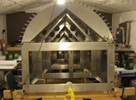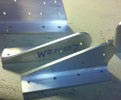


random user submitted photo
Grounding the primary ignition
6 posts
• Page 1 of 1
Grounding the primary ignition
The engine manual suggests a seperate grounding lead due to the fact that the anodizing on the accessory case is insulating. Said lead uses a female disconnect that clips to one of the rivet heads on the front of the coil, but it takes a wider than usual disconnect connector, that I found impossible to locally source. 3M157391-ND works, and you can get them from Digi-Key. https://www.digikey.com/en/products/det ... zlcNRBvgp0
I'm also going to use an externally toothed lock washer on the other end of the 10 gauge wire I will ground to the magnesium case, to cut through the oxide coat on the magnesium, and similar washers to firmly establish an electrical connection when I fasten the module to the case when I reinstall it. I got a brand new module from Sonex, as the top module has NEVER worked on this engine, in spite of hours of troubleshooting by the Job Boss when it was a project of EAA Chapter 393, which you can read about here (sample entry on the ignition failures) https://eaabuilderslog.org/?blprojentry ... tcat=&sid=
I'm also going to use an externally toothed lock washer on the other end of the 10 gauge wire I will ground to the magnesium case, to cut through the oxide coat on the magnesium, and similar washers to firmly establish an electrical connection when I fasten the module to the case when I reinstall it. I got a brand new module from Sonex, as the top module has NEVER worked on this engine, in spite of hours of troubleshooting by the Job Boss when it was a project of EAA Chapter 393, which you can read about here (sample entry on the ignition failures) https://eaabuilderslog.org/?blprojentry ... tcat=&sid=
- karmarepair
- Posts: 193
- Joined: Sun Oct 11, 2020 8:13 pm
Re: Grounding the primary ignition
I don't think grounding to the engine case is critical (or even necessary) here. The circuit you're trying to close is really just between the P-Lead and the Magnetron body. I've had good luck using a shielded wire with the shield connected to one of the Magnetron's mounting screws.
- gammaxy
- Posts: 600
- Joined: Wed Sep 04, 2013 9:31 am
Re: Grounding the primary ignition
The grounding I'm referring to is per page 42 of the engine manual (Rev. AF. 012/22/2021):
"Attach a 20 gauge (minimum) ground wire to the body of each magnatron. The ground wire may be attached to a magnatron mounting bolt, or to one of the "studs" on the metal frame.
Attach the other end of the ground wire to a suitable ground on the engine block.
Do not attach the ground wire to the "P=Lead terminal. This terminal must only be used for the ignition switch wiring.
Apparently, due to the anodizing of the accessory case, the magnatron mounting bolts alone don't provide a reliable enough ground for the primary coils.
"Attach a 20 gauge (minimum) ground wire to the body of each magnatron. The ground wire may be attached to a magnatron mounting bolt, or to one of the "studs" on the metal frame.
Attach the other end of the ground wire to a suitable ground on the engine block.
Do not attach the ground wire to the "P=Lead terminal. This terminal must only be used for the ignition switch wiring.
Apparently, due to the anodizing of the accessory case, the magnatron mounting bolts alone don't provide a reliable enough ground for the primary coils.
- karmarepair
- Posts: 193
- Joined: Sun Oct 11, 2020 8:13 pm
Re: Grounding the primary ignition
I prefer to run a shielded wire between the Magnetron and the ignition switch. The shielding simply connects to one of the mounting screws which should have a pretty solid connection to the body of the Magnetron. The center conductor connects to the P-Lead tab. At the other end, the shielding and center conductor connects to two of the terminals on the switch.
This way you have a well-defined circuit between the switch and the Magnetron and don't have to rely on other grounds and potentially sketchy connections. There's no reason you need a real "ground"--the Magnetron is disabled by simply connecting between the P-Lead tab and its own metal body.
The main benefit to using a shielded wire is you reduce the likelihood of interference from the P-Lead. When the ignition is on, a 90v signal with high frequency components rides on the wire as a potential interference source. Best to contain it within a shielded wire. You probably can't completely overcome all interference since our high voltage ignition wires are also not shielded, but at least they aren't running through the firewall with all your other wires.
Here's what it looks like, notice the vertical scale is in 20v increments.
This way you have a well-defined circuit between the switch and the Magnetron and don't have to rely on other grounds and potentially sketchy connections. There's no reason you need a real "ground"--the Magnetron is disabled by simply connecting between the P-Lead tab and its own metal body.
The main benefit to using a shielded wire is you reduce the likelihood of interference from the P-Lead. When the ignition is on, a 90v signal with high frequency components rides on the wire as a potential interference source. Best to contain it within a shielded wire. You probably can't completely overcome all interference since our high voltage ignition wires are also not shielded, but at least they aren't running through the firewall with all your other wires.
Here's what it looks like, notice the vertical scale is in 20v increments.
- gammaxy
- Posts: 600
- Joined: Wed Sep 04, 2013 9:31 am
Re: Grounding the primary ignition
All above is very true, but one thing is missing about grounding the coils. the plug HV has to have a good ground return to get a nice blue, hot spark at the plug gap. Guess where the HV return path is...on the coil frame mounted to the anodized case. The little ground lug refured to is pretty important, IMHO, to be able to get reliable, hot spark. The 'button' refurred to for magnatron grounding is solderable, and I wrapped a large wire...16 ga?...wire around and soldered it to the button, and, of course, the other end was luged to fit under a good size case bolt, with toothed washers fo give 'bite ' into the metal, and keep it tight too. You should get a nice hot plug spark, and since the mag is securely grounded to the massive grounding system for the engine itself, it would also inhance noise reduction from the ignition system by removing the anodized 'semi-grounding' aluded to.
PS: I loved the waveform capture! great job on that!!
PS: I loved the waveform capture! great job on that!!
Joe Nelsen
scratch built :D
Sirpeedee, N502PD, s/n 1510, Aero Vee 2.1 s/n 0870,
ADS-B in (Stratux)/out(SkyBeacon)
Flying @81.7
KGYI/N. Tx Reg/Perrin Field
EAA Technical Counselor, Chapter 323, Sherman, TX
scratch built :D
Sirpeedee, N502PD, s/n 1510, Aero Vee 2.1 s/n 0870,
ADS-B in (Stratux)/out(SkyBeacon)
Flying @81.7
KGYI/N. Tx Reg/Perrin Field
EAA Technical Counselor, Chapter 323, Sherman, TX
-

n502pd - Posts: 380
- Joined: Sat Feb 23, 2013 12:13 am
- Location: Gunter, Texas
Re: Grounding the primary ignition
n502pd wrote:All above is very true, but one thing is missing about grounding the coils. the plug HV has to have a good ground return to get a nice blue, hot spark at the plug gap. Guess where the HV return path is...on the coil frame mounted to the anodized case.
The common Briggs and Stratton magnetrons that only have a single spark plug wire work exactly how you describe.
Ours have two high voltage wires connected to each end of the "secondary" coil. The circuit is completed through them and not the coil frame. This means that both spark plugs must fire and the current gets conducted through the engine between the plugs. (an interesting detail is both plugs end up with opposite polarity, so I think you should be able to inspect the electrode erosion to determine which side of the engine they were installed on).
This can be verified by measuring the resistance between either spark plug wire and the coil frame. It is an open circuit. If it weren't, it would be because the center of the coil is tied to the frame. I believe this configuration would allow whichever plug fires first to fire, completely suppressing the other. If the wasted spark is easier to fire, the coil would be useless.
If you disconnect one spark plug wire and the other manages to continue to fire, it is likely because the current found a way to arc between the coil frame and the coil. This might be nice in an emergency, but I believe is very bad for the coil (it damages the internal insulation and becomes a point where arcing could happen in the future). For this reason, I avoid ever running the engine (on either ignition) without both plugs properly installed. I suspect some issues people have with the coils are from doing experiments with only one plug installed.
Nothing wrong with grounding the coils however you want, but the reality is they work just fine even if they are electrically insulated from the airframe. If you want to be able to turn them off, you can rely on a ground connection to complete the p-lead circuit to the switch or just run two wires directly to the switch.
- gammaxy
- Posts: 600
- Joined: Wed Sep 04, 2013 9:31 am
6 posts
• Page 1 of 1
Who is online
Users browsing this forum: No registered users and 35 guests







